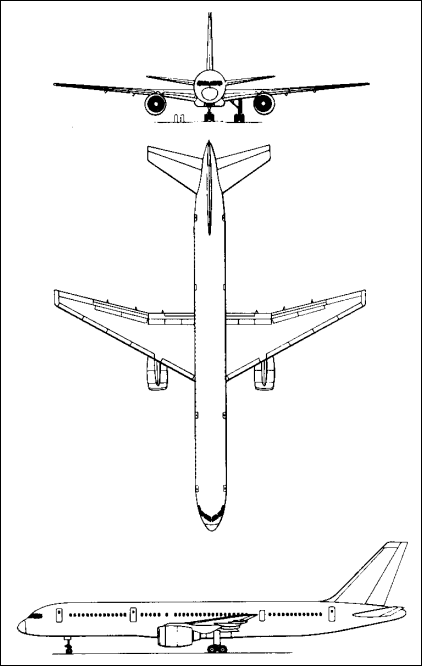 |
Boeing 7571982 |  |
| PASSENGER | Virtual Aircraft Museum / USA / Boeing |
 |
Increased-capacity versions of the highly successful Boeing Model 727 have been studied over the years, but despite several proposals none succeeded in attracting sufficient orders to warrant a production go-ahead. In the early months of 1978, however, the company announced that it proposed to develop a new family of advanced technology aircraft. Retaining the 7X7 designation formula, these three new designs carried the identifications Model 757, Model 767 and Model 777, the first of the three differing by retaining the same fuselage cross-section as the Model 727, whereas the Models 767 and 777 have a fuselage cross-section that is virtually mid-way between that of the Models 727 and 747. A short/medium-range airliner, having a typical capacity of 178 mixed-class, or 196 tourist-class, or a maximum high-density seating arrangement for 224 passengers, the Model 757 provides its operators with new standards of fuel efficiency, now a vital area in the economics of airline operations. The Model 757 is one of the world's most economical turbofan-powered airliners in the short/medium-range category, showing a fuel saving of 45 per cent per passenger by comparison with earlier medium-range aircraft. This results from the combination of a new advanced-technology wing, high by-pass ratio turbofan engines, and avionics equipment that enables the aircraft to be operated at optimum efficiency. The development programme of the Model 767 was some five months in advance of that of the Model 757, principally because the go-ahead for its construction was given some eight months before that of the Model 757. Initial orders for this latter aircraft, which has the designation Model 757-200, were announced on 31 August 1978, comprising 19 and 21 respectively for British Airways and Eastern Air Lines, and after contract finalisation in early 1979, the company announced a production go-ahead on 23 March 1979. The five-month gap between the programmes was essential for Boeing's management and control of the almost simultaneous development of two new major aircraft, but the Model 757 enjoyed the benefits of work already completed on its wide-body sister, for there is a considerable degree of commonality between the two aircraft. However, some 53%, by value, of the Model 757 is being manufactured by outside companies, and major sub-contractors include Avco Aerostructures (wing centre section and fuselage keel), Fairchild Industries (overwing cabin section and wing leading-edge slats), Rockwell International (forward and aft fuselage sections) and Vought Corporation (fuselage tail cone, tailplane and fin). Powerplant comprises two Rolls-Royce RB211-535C or Pratt & Whitney PW2037 turbofan engines, which are mounted in underwing pods, but the two launching airlines opted for Rolls-Royce engines, and this was the first time that Boeing had introduced a new airliner with a non-American powerplant. Follow-on engines (RB211-535E4 and PW2040) are now available with greater thrust. The new-technology wing has less sweep-back than that of the Model 727, and the Model 757's fuselage is 5.97m longer. Landing gear is of tricycle type, each main unit having a four-wheel bogie, with twin wheels on the nose gear. The Model 757 is operated by a flight crew of two, or three optionally, and the advanced avionics available to them include an inertial reference system incorporating laser gyroscopes, a flight management computer system, and a digital air data computer. These integrate to provide optimum fuel efficiency when linked to automatic flight control and thrust management systems. This new generation avionics control is capable of handling an entire flight from shortly after take-off, includ-ing the landing if desirable, with the flight crew functioning as systems managers. The first flight of a Model 757 took place in February 1982, and orders and options for 632 aircraft had been received by the end of March 1990. A 757-200M Combi version is available, as is the 757-200PF Package Freighter and a corporate version.

|  COMPANY PROFILE | ||||||||||||||||||||||||||||||||||||||||||||||||||||||||||||
 |

|

